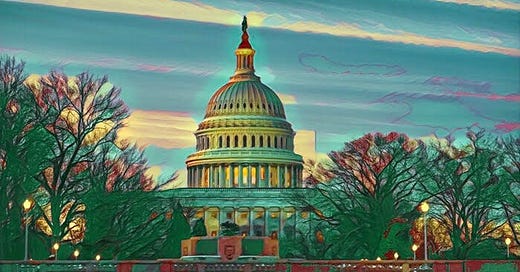BREAKING NEWS: Deal Reached for the Inflation Reduction Act
An agreement has been made on a new bill that is set to spend billions on energy and climate related programs.
Source: NBC News
Wednesday evening, an agreement was reached between Senator Joe Manchin and Senate Majority Leader Chuck Schumer to vote on the 725-page Inflation Reduction Act (IRA) of 2022. Prior to other proposed legislation by the administration, this bill focuses on two sectors only: the energy sector and healthcare. What is causing a reaction from the public is the proposed climate-related components that could have a drastic effect on the energy sector for years to come. This bill will allocate billions of dollars to reduce energy costs, increase American energy security, as well as set a new target of reducing emissions by 40% by 2030. There are a variety of rebates, tax credits, and projects proposed to accelerate the energy transition as well as mitigate the effects of climate change.
In a statement released by Joe Manchin, “In addition to fighting inflation, we must stop pretending that there is only one way to combat global climate change or achieve American energy independence. The Inflation Reduction Act of 2022 addresses our nation’s energy and climate crisis by adopting commonsense solutions through strategic and historic investments that allow us to decarbonize while ensuring American energy is affordable, reliable, clean and secure. The need to balance all of these critical energy priorities is no longer open to debate given the energy threats we face.” [1]
If this bill passes, it will be one of the biggest climate investments to date in US history.
Top 5 Energy Proposals
There are five components we want to highlight that would impact the energy sector today. [2]
1. Lower Energy Costs: This bill would target lower energy costs by deploying capital to consumer home rebate programs, providing tax credits to make homes more energy efficient, and a grant program to make affordable housing more energy efficient.
2. Focus on American Energy security: The bill would invest in clean energy manufacturing and transportation technologies. The goal would be to help alleviate inflation and reduce the risk of future price shocks by bringing the cost of clean energy down. Tax credits would be used to increase the development of sustainable energy production like turbines, solar panels, and critical mineral processing. As of today, a production tax credit for wind is expired meaning that new projects that begin in 2022 won’t receive any incentives. However, with this proposal, credits would be given to new wind projects until 2024. A significant amount of money would also be invested in building clean technology manufacturing facilities to develop turbines or solar panels.
3. Decarbonization & Methane Reduction: a variety of tax credits would be used for clean energy sources, storage, and for utility companies to transition to clean sources. Tax credits would also be used for the automotive industry and for large chemical and steel companies to reduce emissions. Lastly, a Methane Reduction Program would be established to identify and reduce leaks from natural gas distribution and production. This also includes a fee associated with any methane leaks.
4. The bill proposes a variety of social and environmental justice programs to support disadvantaged communities. These include the Environmental and Climate Justice Block Grants and the Neighborhood Access and Equity Grants which both focus on supporting disadvantaged communities that could be impacted by the energy transition and climate change. Other proposed projects include investments toward clean heavy-duty vehicles and grants to reduce air pollution at ports.
5. The bill also focuses on sustainable agriculture, investments in sustainable fuels, and grants to protect coastal habitats.
Source: The Washington Post
As mentioned earlier, this legislation focuses on Health Care and Energy and is not intended to be a replacement for the Build Back Better. This bill, even budgeted at $740B, is still significantly smaller than the Build Back better which was proposed at $5 Trillion and would have impacted the government’s debt significantly. Another key difference is the Build Back Better focused not only on healthcare but also childcare, housing, and Medicare. With so many different policy proposals it was extremely challenging to message the objectives but some also argued the true cost of the bill wasn’t reflected in the price.
Acceleration of Electric Vehicle Development and Adoption
This bill has a large focus on reforms for EV Policy, commercial EV development, and EV manufacturing. Included in the proposal are tax credits for electric vehicles, the development of hydrogen fuel cells, and the removal of the EV tax credit cap which originally proposed that consumers would not receive their full $7,500 credit if they had purchased an EV from a manufacturer who had sold over 200K EVs (interesting, right?). To support the potential new demand for EVs, this bill would also require that consumers who want the tax credit would have to purchase EVs that use a certain percentage of materials made in North America or from countries that have free-trade agreements with the US. EVs require a significant amount of minerals to make their batteries including lithium, nickel, copper, cobalt, and other rare earth elements.
Methane Reduction Programs Target Oil & Gas
Another bill that made it into the legislation is the Methane Reduction Program. Methane is a greenhouse gas that is about 25x more potent than carbon and traps more heat than CO2. Specifically, for O&G companies, this program will deploy over $1.5B to monitor and mitigate methane leaks within pipelines along with leak detection technologies. Additionally, similar to the Build Back Better bill, fines would be charged to O&G companies that emit a certain amount of greenhouse gases. The fee is proposed to increase over time and could potentially rise to $1,200 in 2025 per ton of excess methane. According to Bloomberg, some of the highest emitting upstream and midstream companies include the supermajors like Exxon, ConocoPhillips, and other large companies like Williams and Occidental. [3]
[1] https://www.manchin.senate.gov/newsroom/press-releases/manchin-supports-inflation-reduction-act-of-2022
[3]https://www.bnef.com/loginr=%2Finsights%2F29453%2Fview%3Fe%3DAnalyst%2520Reaction%253Asailthru







